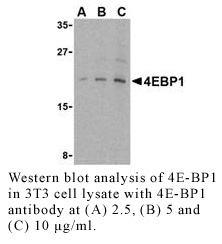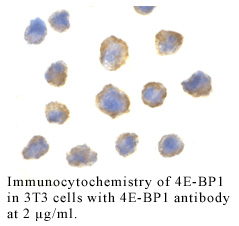Anti-Human Initiation Factor 4E Binding Protein 1 (4E-BP1)
Data
- -
- -
Antibody DetailsProduct DetailsReactive Species Human Host Species Rabbit Immunogen PN:I-459 Product Concentration 0.5 mg/ml Formulation This polyclonal antibody is formulated in phosphate buffered saline (PBS) pH 7.4 containing 0.02% sodium azide as a preservative. Storage and Handling This polyclonal antibody is stable for at least one week when stored at 2-8°C. For long term storage, aliquot in working volumes without diluting and store at –20°C in a manual defrost freezer. Avoid Repeated Freeze Thaw Cycles. Country of Origin USA Shipping Next Day Ambient RRIDAB_2830696 Each investigator should determine their own optimal working dilution for specific applications. See directions on lot specific datasheets, as information may periodically change. DescriptionDescriptionSpecificity Rabbit Anti-Human Initiation Factor 4E Binding Protein 1 (4E-BP1) recognizes Human and Mouse 4E-BP1. This polyclonal antibody was purified using affinity chromatography. Background The translation of mRNA in eukaryotic cells is regulated by the presence of amino acids through multiple mechanisms (reviewed in 1). One such mechanism involves the evolutionarily conserved serine/threonine kinase TOR (Target of rapamycin, also known as mTOR), which regulates cell growth and cell cycle through its ability to integrate signals from nutrient levels and growth factors (reviewed in 2). One downstream target of TOR is the eukaryotic initiation factor 4E binding protein 1 (4E-BP1) whose phosphorylation prevents its association with eIF4E, preferentially stimulating translation of mRNAs containing long, highly structured 5’-UTRs.1 Rapamycin inhibits TOR resulting in reduced cell growth and reduced rates of cell cycle and cell proliferation (reviewed in 3), at least in part by inhibiting the activity of TOR towards 4E-BP1. References & Citations1. Shah, OJ. et al. (2000) Am. J. Physiol. Endocrinol. Metab. 279:E715 2. Shamji, AF. et al. (2003) Mol. Cell 12:271 Technical ProtocolsCertificate of Analysis |
Related Products
- -
- -
Prod No. | Description |
|---|---|
I-458 | |
I-459 |




